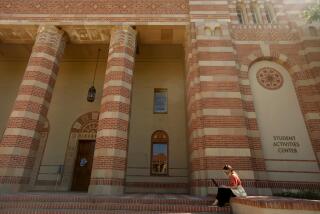Students push UC to expand terms of ethnic identification
- Share via
Nicole Salame, 19, was filling out an application to UCLA last year when she got to the question about race and ethnicity. She thought a mistake had been made.
“I read it five times and was like, where is Middle Eastern?” the freshman recently recalled. “Is it on the other page, did it get cut off? I thought they forgot.”
Her Lebanese-born mother told her Arabs are considered white, but Salame didn’t believe her. Her high school counselor told her the same thing.
“It did not make sense to me, it’s so far-fetched,” said Salame, who ended up checking “Other.”
For years the federal government has classified Arab Americans and Middle Easterners as white. But confusion and disagreement have led some students to check “Asian” or “African,” depending on what part of the Middle East they came from. Some, like Salame, simply marked “Other.”
Now several UCLA student groups -- including Arabs, Iranians, Afghanis and Armenians -- have launched a campaign to add a Middle Eastern category, with various subgroups, to the University of California admissions application. They hope to emulate the Asian Pacific Coalition’s “Count Me In” campaign, which a few years ago successfully lobbied for the inclusion of 23 ethnic categories on the UC application, including Hmong, Pakistani, Native Hawaiian and Samoan.
The UCLA students said having their own ethnic designation goes beyond self-identity and has real implications for the larger Arab and Middle Eastern communities.
The “white” label can hurt them with universities and companies that use the information to promote diversity, they say, and can result in the gathering of little or no statistical data on important issues, such as health trends in the community. Voter-approved Proposition 209 bars California’s public colleges from considering race in admissions.
The Arab American Institute estimates that including Middle Easterners in the white category on the census has led to a population undercount of more than a million, said Helen Samhan, who works at the institute. There are more than 3 million Arabs in the United States, the institute says.
There is no count of Middle Easterners at UCLA. Student groups estimate that there are hundreds, perhaps thousands, of Persians and Arabs among the more than 40,000 students on campus.
“It’s not just about wanting a category on a form,” said Sarah Gualtieri, a USC professor of American studies and ethnicity. “I think you see particularly among a younger population a desire to really claim . . . both sides of the hyphen of Arab and American.”
Gualtieri is the author of a forthcoming book, “Between Arab and White: Race and Ethnicity in the Early Syrian American Diaspora,” that explores how Syrian immigrants, who were considered Asian, waged a legal battle in the early 1900s to be classified as white and thus eligible for citizenship. At the time some were barred by the courts under the Asian Exclusion Act.
That classification was cemented in the late 1970s when the Office of Management and Budget, a federal agency, listed all Middle Easterners as white.
But in the last few decades there has been a push to establish a separate category as the general population has grown more diverse and because of the possible benefits it could bring.
“Back then, to get rights you needed to be white,” said Yasi Chehroudi, president of the Iranian Student Group, which is helping spearhead the University of California campaign. “Now it helps to be yourself.”
UC officials are aware of the UCLA students’ campaign and are exploring the possibility of changing the ethnic categories on the university’s application form, said Nina Robinson, director of policy for the Department of Student Affairs. A decision could come in the next six months.
But any change in ethnicity categories could affect data trends, Robinson said. For example, if those who in the past would have checked white were to start checking another category, it would appear as a sudden drop in white applicants.
“It’s reasonable that Middle Eastern people don’t like to be lumped in with white, so I think there’s a lot of sympathy for the issue,” Robinson said. “But there are also a lot of issues” to consider.
In a 1997 report on the census, the Office of Management and Budget pointed out that while Arab Americans suffer from stereotyping, they tend to be more educated and affluent than the average American. The report questioned whether they should be placed in a minority category, which could increase their chances for benefits aimed at the socially and economically disadvantaged. Some in the Middle Eastern community agree.
But UCLA junior Shawn Gabrill said he has more in common with other children of immigrants than with those whose parents were born in this country.
“I feel like when I put down ‘white’ on an application, they assume my parents finished high school, went to college and that English was my first language,” the 20-year-old English major said. “And none of these things describe me.”
Gabrill, the son of Jordanian and Egyptian parents, said he had difficulties with the college application but, because he was seen as white, he wasn’t identified as someone who needed extra help from high school counselors.
“So it’s kind of like we’re in between. We’re not white, but we’re not as disadvantaged as the other groups so we don’t get any of that aid,” he said. “So we’re kind of invisible in that way.”
--
More to Read
Sign up for Essential California
The most important California stories and recommendations in your inbox every morning.
You may occasionally receive promotional content from the Los Angeles Times.











